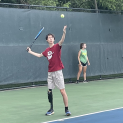Validation of microRNAs as valid targets in a pediatric sarcoma
Rhabdomyosarcoma is the most common soft tissue cancer in childhood. Despite rigorous clinical trials, the survival for children with high-risk rhabdomyosarcoma has not changed for three decades. The children that do survive often suffer from life-long disfigurements as a result of the aggressive treatment. Thus, there is a tremendous need for the development of novel treatments of this disease. Rhabdomyosarcoma resembles developing skeletal muscle and has been speculated to originate from genetically compromised skeletal muscle progenitors. However, the genes that control rhabdomyosarcoma development remain elusive. MicroRNAs (miRs) are a recently recognized class of genes normally produced in cells that perform critical roles in normal physiology and in disease. Many recent studies illustrate that miRs actively participate in cancer, thus identifying new anti-cancer targets. Unfortunately, very little is known about miRs in rhabdomyosarcoma. My laboratory is focused on understanding how miRs contribute to rhabdomyosarcoma development. The overall goal of my lab is to identify new methods to target and treat this cancer. We have characterized a novel mouse model of rhabdomyosarcoma that more closely represents the human disease and used this model to determine miRs that are overrepresented in these tumors. In this proposal, we utilize genetically engineered mice and human rhabdomyosarcoma cells to determine the role of these overrepresented miRs in rhabdomyosarcoma development. In addition, we are treating rhabdomyosarcoma mice with miR inhibitors as a proof-of-concept for whether we could use these molecules to treat rhabdomyosarcoma. We hope that inhibition of miRs will provide a new strategy to treat rhabdomyosarcoma.

